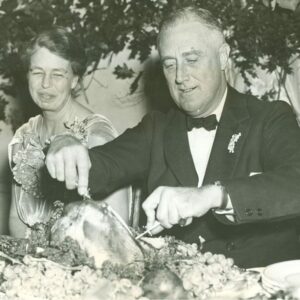Imagine a formal White House meal. Glistening silver, glittering china, gleaming crystal. And the food! The chow there is good.
Except once during the 20th century when the woman charged with feeding the president served meals that were so bad guests cringed. That hottest ticket in Washington, an invitation to dine with the president, was something to dread. “Eat before you go to the White House” was the rule then.
Incredibly, the man who brought down Hitler and Mussolini was powerless to do anything about the dictator under his own roof.
Meet the Tyrant of the White House Kitchen.
When Franklin Roosevelt was elected president, he and wife Eleanor reached an understanding. She would run the White House, he would run the nation, and neither would intrude on the other’s turf.
As Franklin lined up his administration, Eleanor set about her own task. One day she knocked on Mrs. Henrietta Nesbitt’s door in Hyde Park, N.Y. and invited her to become the White House housekeeper.
Mrs. Nesbitt was not only flabbergasted, she was also an unlikely pick. While she had cooked for her family for years (something the wealthy Eleanor never had to bother with) and sold homemade bread and cakes when her husband lost his job, she had no restaurant, hotel management, or formal cooking experience.
Which didn’t bother Eleanor a bit. Indifferent to food herself, she dutifully ate whatever was placed before her regardless how it tasted. She and Mrs. Nesbitt attended church and the League of Women Voters together; that was good enough. Eleanor was more concerned that the housekeeper shared her liberal political views than with the type of house she kept. Even when it happened to be the White House.
Mrs. Nesbitt ruled the domestic staff like a Prussian field marshal. Nowhere was her Iron Hand more fiercely felt than the kitchen. As a New Yorker article quipped, “For the next 12 years, Mrs. Nesbitt turned out meals so gray, so drooping, and so spectacularly inept that they became a Washington legend.”
Lunch typically featured chipped beef on toast, broiled kidneys on toast, curried eggs on toast. There was creamed chicken, creamed celery, creamed fish. And a host of sweetbreads (which, to the uninitiated, are the pancreas and thymus glands of lamb, beef, and pork): broiled, braised and, of course, creamed. On toast. (Notice a trend?)
It was cheap, frumpy food. A formal state dinner once featured sweet potato casserole with marshmallows.
Worse still, it was badly cooked. Lillian Parks Rogers, a White House maid from Presidents Taft through Kennedy, noted in her memoirs that although Mrs. Nesbitt didn’t actually prepare the food, “she stood over the cooks, making sure that each dish was overcooked or undercooked or ruined one way or another.”
Mrs. Nesbitt simply ignored FDR. He announced early on he disliked broccoli, yet she kept serving it to him. He would ask for coffee and get iced tea. While sick once he requested canned asparagus. Mrs. Nesbitt told him it was unobtainable; his secretary promptly dashed to a nearby store and returned with 10 cans of it.
Things got so bad, the press even picked up the story. “Same Meal Four Days Irks Roosevelt,” a 1937 New York Times headline said.
Roosevelt told friends in 1944 he wanted to win a fourth term, “just so I can fire Mrs. Nesbitt.” When he was elected, he wanted chicken ala king for this inaugural luncheon. He got chicken salad instead.
Why did he put up with it? Because a deal is a deal. He had given Eleanor authority over the domestic staff in 1933 and to keep peace in the family—if not in his tortured stomach—he honored the arrangement. Mrs. Nesbitt was, in biographer Blanche Wiesen Cook’s words, “Eleanor’s revenge” on the husband whose infidelity had broken her heart. If the goal was to make his life miserable at mealtime it was mission accomplished.
Until April 12, 1945, when FDR had no need of meals anymore. Harry Truman became president upon Roosevelt’s sudden death and moved into the White House.
The Trumans were a meat and potatoes family. They liked their food simple, yet skillfully cooked. But they didn’t get it from Mrs. Nesbitt, who went on with business as usual.
A red flag shot up when, after one meal, Bess Truman said the family wanted all biscuits freshly made, not “store-bought.” The biscuits were fresh, Mrs. Nesbitt insisted, angering the new First Lady. Her grandfather had produced Queen of the Pantry Flour in Missouri, Bess said; she knew “store-bought” when she tasted it.
Bess later told Mrs. Nesbitt the president didn’t like brussels sprouts and asked her not to serve them again. They were on the menu the very next day. When Bess asked about it, Mrs. Nesbitt said the kitchen had plenty of brussels sprouts remaining and the practice was to keep serving food items until they were gone. She made things worse by adding, “That’s how Mrs. Roosevelt did things.” Bess was fuming.
The final straw quickly followed. Bess was assigned to bring a stick of butter to a woman’s club meeting and asked for one. Impossible, the First Lady was told. Wartime rationing was still in place and Mrs. Nesbitt refused to provide it.
Poor Harry Truman. As he pondered using the atomic bomb, how to handle Josef Stalin and the Soviets, plus a hundred other pressing headaches, he had to drop everything to deal with a stick of butter. Truman didn’t have time for trivialities; Mrs. Nesbitt was fired.
No one on the staff was sorry to see her go. Like all tyrants, Mrs. Nesbitt was consigned to the ash heap of culinary history. She was sent packing back to New York (where she wrote a cookbook!) before dying in 1963.
Her legacy lives on at FDR’s Presidential Library in a little eatery called “Mrs. Nesbitt’s Café.”
If you visit Hyde Park, be sure to bring a sack lunch with you.

